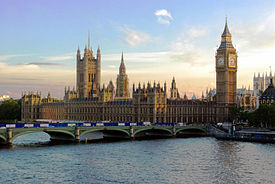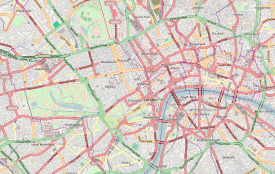Houses of Parliament
| Palace of Westminster | |
|---|---|

The Palace of Westminster with Elizabeth Tower and Westminster Bridge, viewed from across the River Thames
|
|
| Location | City of Westminster, London, United Kingdom |
| Coordinates | 51°29′57″N 00°07′29″W / 51.49917°N 0.12472°WCoordinates: 51°29′57″N 00°07′29″W / 51.49917°N 0.12472°W |
| Area | 112,476m2 (internal) |
| Built | 1016 |
| Demolished | 1834 (due to fire) |
| Rebuilt | 1840–70 |
| Architectural style(s) | Perpendicular Gothic Revival |
| Owner | Queen Elizabeth II in right of the Crown |
| Official name: Palace of Westminster, Westminster Abbey, and St Margaret's Church | |
| Type | Cultural |
| Criteria | i, ii, iv |
| Designated | 1987 (11th session) |
| Reference no. | 426 |
| Country | United Kingdom |
| Region | Europe |
| Extensions | 2008 |
|
Listed Building – Grade I
|
|
| Official name: Houses of Parliament / The Palace of Westminster | |
| Designated | 5 February 1970 |
| Reference no. | 1226284 |
 |
|
|
|
The Palace of Westminster is the meeting place of the House of Commons and the House of Lords, the two houses of the Parliament of the United Kingdom. Commonly known as the Houses of Parliament after its occupants, it is also known as the 'heart of British politics'. The Palace lies on the north bank of the River Thames in the City of Westminster, in central London.
Its name, which derives from the neighbouring Westminster Abbey, may refer to either of two structures: the Old Palace, a medieval building complex destroyed by fire in 1834, and its replacement, the New Palace that stands today. The palace is owned by the monarch in right of the Crown and, for ceremonial purposes, retains its original status as a royal residence. The building is managed by committees appointed by both houses, which report to the Speaker of the House of Commons and the Lord Speaker.
The first royal palace was built on the site in the 11th century, and Westminster was the primary residence of the Kings of England until fire destroyed much of the complex in 1512. After that, it served as the home of the Parliament of England, which had been meeting there since the 13th century, and also as the seat of the Royal Courts of Justice, based in and around Westminster Hall. In 1834, an even greater fire ravaged the heavily rebuilt Houses of Parliament, and the only significant medieval structures to survive were Westminster Hall, the Cloisters of St Stephen's, the Chapel of St Mary Undercroft, and the Jewel Tower.
...
Wikipedia

